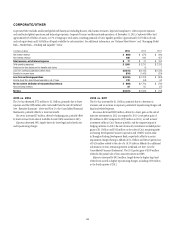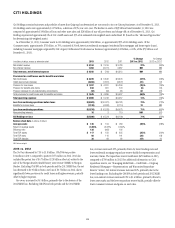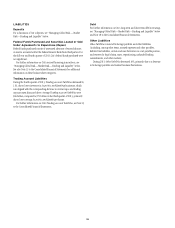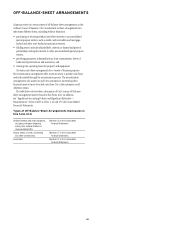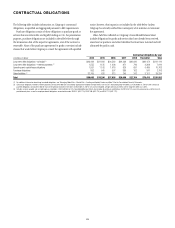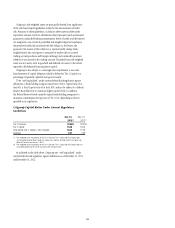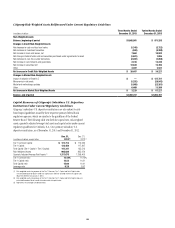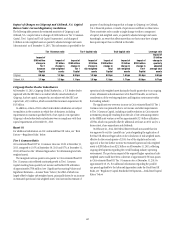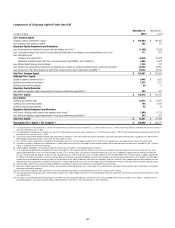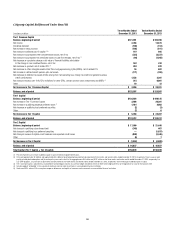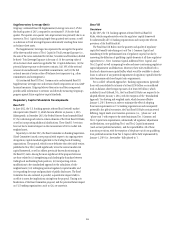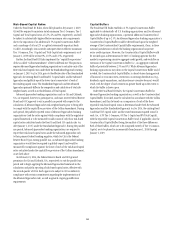Citibank 2013 Annual Report Download - page 60
Download and view the complete annual report
Please find page 60 of the 2013 Citibank annual report below. You can navigate through the pages in the report by either clicking on the pages listed below, or by using the keyword search tool below to find specific information within the annual report.42
CAPITAL RESOURCES
Overview
Capital is used principally to support assets in Citi’s businesses and to
absorb credit, market and operational losses. Citi primarily generates capital
through earnings from its operating businesses. Citi may augment its capital
through issuances of common stock, perpetual preferred stock and equity
issued through awards under employee benefit plans, among other issuances.
During 2013, Citi issued approximately $4.3 billion of noncumulative
perpetual preferred stock, resulting in a total of approximately $6.7 billion
outstanding as of December 31, 2013.
Citi has also previously augmented its regulatory capital through
the issuance of trust preferred securities, although the treatment of such
instruments as regulatory capital will largely be phased out under the
final U.S. Basel III rules (Final Basel III Rules) (see “Regulatory Capital
Standards Developments” below). Accordingly, Citi has continued to redeem
certain of its trust preferred securities in contemplation of such future phase
out (see “Managing Global Risk—Market Risk—Funding and Liquidity—
Long-Term Debt” below).
Further, changes in regulatory and accounting standards as well as the
impact of future events on Citi’s business results, such as corporate and asset
dispositions, may also affect Citi’s capital levels.
Citigroup’s capital management framework is designed to ensure that
Citigroup and its principal subsidiaries maintain sufficient capital consistent
with each entity’s respective risk profile and all applicable regulatory
standards and guidelines. Citi assesses its capital adequacy against a series
of internal quantitative capital goals, designed to evaluate the Company’s
capital levels in expected and stressed economic environments. Underlying
these internal quantitative capital goals are strategic capital considerations,
centered on preserving and building financial strength. Senior management,
with oversight from the Board of Directors, is responsible for the capital
assessment and planning process, which is integrated into Citi’s capital plan,
as part of the Federal Reserve Board’s Comprehensive Capital Analysis and
Review (CCAR) process. Implementation of the capital plan is carried out
mainly through Citigroup’s Asset and Liability Committee, with oversight
from the Risk Management and Finance Committee of Citigroup’s Board of
Directors. Asset and liability committees are also established globally and for
each significant legal entity, region, country and/or major line of business.
Current Regulatory Capital Guidelines
Citigroup Capital Resources Under Current Regulatory
Guidelines
Citigroup is subject to the risk-based capital guidelines issued by the Federal
Reserve Board which currently constitute the Basel I credit risk capital
rules and also the final (revised) market risk capital rules (Basel II.5).
Commencing with 2014, Citi’s regulatory capital ratios will reflect, in part,
the implementation of certain aspects of the Final Basel III Rules, such as
those related to the transitioning toward qualifying capital components,
including the application of regulatory capital adjustments and deductions.
In addition, effective with the second quarter of 2014, Citi will begin applying
the Basel III Advanced Approaches rules. For additional information
regarding the implementation of the Final Basel III Rules, see “Regulatory
Capital Standards Developments” below.
Historically, capital adequacy has been measured, in part, based on
two risk-based capital ratios, the Tier 1 Capital and Total Capital (Tier 1
Capital + Tier 2 Capital) ratios. Tier 1 Capital consists of the sum of “core
capital elements,” such as qualifying common stockholders’ equity, as
adjusted, qualifying perpetual preferred stock, qualifying noncontrolling
interests, and qualifying trust preferred securities, principally reduced by
goodwill, other disallowed intangible assets, and disallowed deferred tax
assets. Total Capital also includes “supplementary” Tier 2 Capital elements,
such as qualifying subordinated debt and a limited portion of the allowance
for credit losses. Both measures of capital adequacy are stated as a percentage
of risk-weighted assets.
In 2009, the U.S. banking regulators developed a supervisory measure
of capital termed “Tier 1 Common,” which is defined as Tier 1 Capital less
non-common elements, including qualifying perpetual preferred stock,
qualifying noncontrolling interests, and qualifying trust preferred securities.
Until January 1, 2015, the Federal Reserve Board has retained this definition
of Tier 1 Common Capital for CCAR purposes, which differs substantially
from the more restrictive definition under the Final Basel III Rules. Moreover,
the presentation of Tier 1 Common Capital and related ratio in the tables
that follow, labeled “Current Regulatory Guidelines”, are also consistent in
derivation with this supervisory definition.


